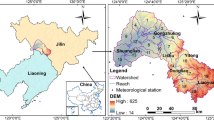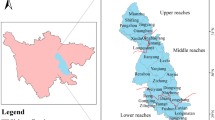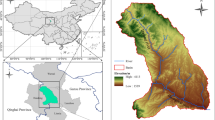Abstract
Non-point source (NPS) pollution has become a major source of water pollution. A combination of models would provide the necessary direction and approaches designed to control NPS pollution through land use planning. In this study, NPS pollution load was simulated in urban planning, historic trends and ecological protection land use scenarios based on the Conversion of Land Use and its Effect at Small regional extent (CLUE-S) and Soil and Water Assessment Tool (SWAT) models applied to Hunhe-Taizi River Watershed, Liaoning Province, China. Total nitrogen (TN) and total phosphorus (TP) were chosen as NPS pollution indices. The results of models validation showed that CLUE-S and SWAT models were suitable in the study area. NPS pollution mainly came from dry farmland, paddy, rural and urban areas. The spatial distribution of TN and TP exhibited the same trend in 57 sub-catchments. The TN and TP had the highest NPS pollution load in the western and central plains, which concentrated the urban area and farm land. The NPS pollution load would increase in the urban planning and historic trends scenarios, and would be even higher in the urban planning scenario. However, the NPS pollution load decreased in the ecological protection scenario. The differences observed in the three scenarios indicated that land use had a degree of impact on NPS pollution, which showed that scientific and ecologically sound construction could effectively reduce the NPS pollution load in a watershed. This study provides a scientific method for conducting NPS pollution research at the watershed scale, a scientific basis for non-point source pollution control, and a reference for related policy making.
Similar content being viewed by others
Explore related subjects
Discover the latest articles and news from researchers in related subjects, suggested using machine learning.References
Ahearn D S, Sheibley R W, Dahlgren R A et al., 2005. Land use and land cover influence on water quality in the last free-flowing river draining the western Sierra Nevada, California. Journal of Hydrology, 313(3–4): 234–247. doi: 10.1016/j.jhydrol.2005.02.038
Arhonditsis G, Tsirtsis G, Angelidis M O et al., 2000. Quantification of the effects of nonpoint nutrient sources to coastal marine eutrophication: Applications to a semi-enclosed gulf in the Mediterranean Sea. Ecological Modelling, 129(2–3): 209–227. doi: 10.1016/S0304-3800(00)00239-8
Arnold J G, Srinivasan R, Muttiah R S et al., 1998. Large area hydrologic modelling and assessment. Part I: Model development. Journal of the American Water Resources Association, 34(1): 73–89. doi: 10.1111/j.1752-1688.1998.tb05961.x
Behera S, Panda R K, 2006. Evaluation of management alternatives for an agricultural watershed in a sub-humid subtropical region using a physical process based model. Agriculture, Ecosystems & Environment, 113(1–4): 62–72. doi: 10.1016/j.agee.2005.08.032
Castella J C, Verburg P H, 2007. Combination of process-oriented and pattern-oriented models of land-use change in a mountain area of Vietnam. Ecological Modelling, 202(3–4): 410–420. doi: 10.1016/j.ecolmodel.2006.11.011
Cheng Shiying, 2001. Water environmental protection and counter measures of urban agglomeration in the central region of Liaoning Province. Water Resourse & Hydropower of Northeast China, 19(12): 39–41. (in Chinese)
Cohen J A, 1960. Coefficient agreement for nominal data. Educational and Psychological Measurement, 2(1): 37–46.
Department of Environmental Protection of Liaoning Province, 2011. Liaoning Province Environmental Bulletin in 2011. Shenyang: Department of Environmental Protection of Liaoning Province, 33–38.
Gosain A K, Rao S, Srinivasan R et al., 2005. Return-flow assessment for irrigation command in the Palleru River Basin using SWAT model. Hydrological Processes, 19(3): 673–682. doi: 10.1002/hyp.5622
Gunes K, 2008. Point and nonpoint sources of nutrients to lakes—Ecotechnological measures and mitigation methodologies—Case study. Ecological Engineering, 34(2): 116–126. doi: 10.1016/j.ecoleng.2008.07.004
Hao F B, Zhang X S, Yang Z F, 2004. A distributed non-point source pollution model: Calibration and validation in the Yellow River Basin. Journal of Environmental Sciences, 16(4): 646–650.
Hollis G E, 1975. The effect of urbanization on floods of different recurrence interval. Water Resources Research, 11(3): 431–435. doi: 10.1029/WR011i003p00431
Hundecha Y, Bárdossy A, 2004. Modeling of the effect of land use changes on the runoff generation of a river basin through parameter regionalization of a watershed model. Journal of Hydrology, 292(1–4): 281–295. doi: 10.1016/j.jhydrol.2004.01.002
Lai Y C, Yang C P, Hsieh C Y et al., 2011. Evaluation of non-point source pollution and river water quality using a multimedia two-model system. Journal of Hydrology, 409(3–4): 583–595. doi: 10.1016/j.jhydrol.2011.08.040
Lambin E F, Turner B L, Geist H J et al., 2001. The causes of land-use and land-cover change: Moving beyond the myths. Global Environmental Change, 11(4): 261–269. doi: 10.1016/S0959-3780(01)00007-3
Liaoning Statistics Bureau, 1988. Liaoning Statistical Yearbook 1987. Beijing: China Statistics Press, 246–248. (in Chinese)
Liaoning Statistics Bureau, 1997. Liaoning Statistical Yearbook 1996. Beijing: China Statistics Press, 136–143. (in Chinese)
Liaoning Statistics Bureau, 2001. Liaoning Statistical Yearbook 2000. Beijing: China Statistics Press, 308–312. (in Chinese)
Liaoning Statistics Bureau, 2004. Liaoning Statistical Yearbook 2003. Beijing: China Statistics Press, 128–135. (in Chinese)
Liaoning Statistics Bureau, 2005. Liaoning Statistical Yearbook 2004. Beijing: China Statistics Press, 368–482. (in Chinese)
Liaoning Statistics Bureau, 2010. Liaoning Statistical Yearbook 2009. Beijing: China Statistics Press, 287–298. (in Chinese)
Lindenschmidt K E, Fleischbein K, Baborowski M, 2007. Structural uncertainty in a river water quality modelling system. Ecological Modelling, 204(3–4): 289–300. doi: 10.1016/j.ecolmodel.2007.01.004
Liu Miao, Hu Yuanman, Sun Fengyun et al., 2012. Application of land use model CLUE-S in the planning of central Liaoningurban agglomerations. Chinese Journal of Ecology, 31(2): 413–420. (in Chinese)
Logsdon R A, Chaubey I, 2013. A quantitative approach to evaluating ecosystem services. Ecological Modelling, 257: 57–65. doi: 10.1016/j.ecolmodel.2013.02.009
Mapfumo E, Chanasyk D S, Willms W D, 2004. Simulating daily soil water under foothills fescue grazing with the soil and water assessment tool model (Alberta, Canada). Hydrological Processes, 18(15): 2787–2800. doi: 10.1002/hyp.1493
Monserud R A, Leemans R, 1992. Comparing global vegetation maps with the Kappa statistic. Ecological Modelling, 62(4): 275–293. doi: 10.1016/0304-3800(92)90003-W
Næsset E, 1996. Use of the weighted Kappa coefficient in classification error assessment of thematic maps. International Journal of Geographical Information Systems, 10(5): 591–603. doi: 10.1080/02693799608902099
Nash J E, Sutcliffe J V, 1970. River flow forecasting through conceptual models part I—A discussion of principles. Journal of Hydrology, 10(3): 282–290. doi: 10.1016/0022-1694(70)90255-6
Oeurng C, Sauvage S, Sánchez-Pérez J M, 2011. Assessment of hydrology, sediment and particulate organic carbon yield in a large agricultural catchment using the SWAT model. Journal of Hydrology, 401(3–4): 145–153. doi: 10.1016/j.jhydrol.2011.02.017
Ouyang W, Huang H, Hao F et al., 2013. Synergistic impacts of land-use change and soil property variation on non-point source nitrogen pollution in a freeze-thaw area. Journal of Hydrology, 495: 126–134. doi: 10.1016/j.jhydrol.2013.04.037
Ouyang W, Wang X, Hao F et al., 2009. Temporal-spatial dynamics of vegetation variation on non-point source nutrient pollution. Ecological Modelling, 220(20): 2702–2713. doi: 10.1016/j.ecolmodel.2009.06.039
Pandey V K, Panda S N, Sudhakar S, 2005. Modelling of an Agricultural Watershed using Remote Sensing and a Geographic Information System. Biosystems Engineering, 90(3): 331–347. doi: 10.1016/j.biosystemseng.2004.10.001
Pontius R G, Schneider L C, 2001. Land-cover change model validation by an ROC method for the Ipswich watershed, Massachusetts, USA. Agriculture, Ecosystems & Environment, 85(1–3): 239–248. doi: 10.1016/S0167-8809(01)00187-6
Robinson T H, Leydecker A, Keller A A et al., 2005. Steps towards modeling nutrient export in coastal Californian streams with a Mediterranean climate. Agricultural Water Management, 77(1–3): 144–158. doi: 10.1016/j.agwat.2004.09.024
Sadeghi S H R, Jalili K, Nikkami D, 2009. Land use optimization in watershed scale. Land Use Policy, 26(2): 186–193. doi: 10.1016/j.landusepol.2008.02.007
Seppelt R, Voinov A, 2002. Optimization methodology for land use patterns using spatially explicit landscape models. Ecological Modelling, 151(2–3): 125–142. doi: 10.1016/S0304-3800(01)00455-0
Setegn S G, Srinivasan R, Dargahi B et al., 2009. Spatial delineation of soil erosion vulnerability in the Lake Tana Basin, Ethiopia. Hydrological Processes, 23(26): 3738–3750. doi: 10.1002/hyp.7476
Shen Z, Chen L, Hong Q, et al., 2013. Vertical variation of nonpoint source pollutants in the Three Gorges Reservoir Region. PLoS ONE, 8(8): e71194. doi: 10.1371/journal.pone.0071194
Sun H, Cornish P S, 2005. Estimating shallow groundwater recharge in the headwaters of the Liverpool Plains using SWAT. Hydrological Processes, 19(3): 795–807. doi: 10.1002/hyp.5617
U.S. Geological Survey, 1999. The Quality of Our Nation’s Waters—Nutrients and Pesticides: U.S. Geological Survey Cir cular, 1225–1282.
Verburg P H, Schot P P, Dijst M J et al., 2004. Land use change modelling: Current practice and research priorities. GeoJournal, 61(4): 309–324. doi: 10.1007/s10708-004-4946-y
Verburg P H, Soepboer W, Veldkamp A et al., 2002. Modelingthe spatial dynamics of regional land use: The CLUE-S model. Environmental Management, 30(3): 391–405. doi: 10.1007/s00267-002-2630-x
Xu Xia, Liu Haipeng, Gao Qiong, 2008. Dynamic simulation on the optimal patterns of land use change for the farming-past or zone in North China. Progress in Geography, 27(3): 80–85. (in Chinese)
Zhang P, Liu Y, Pan Y et al., 2013. Land use pattern optimization based on CLUE-S and SWAT models for agricultural non-point source pollution control. Mathematical and Computer Modelling, 58(3–4): 588–595. doi: 10.1016/j.mcm.2011.10.061
Zhang Yongmin, Zhao Shidong, Zhang Kebin, 2003. Simulation of changes in spatial pattern of land use in Horqin desert and its outer area. Journal of Beijing Forestry University, 25(3): 68–73. (in Chinese)
Zhu Junjun, Hu Yuanman, Liu Miao et al., 2011. Landscape change and its driving forces in Hun-Tai River Basin. Chinese Journal of Ecology, 30(1): 112–118. (in Chinese)
Author information
Authors and Affiliations
Corresponding author
Additional information
Foundation item: Under the auspices of National Natural Science Foundation of China (No. 41171155, 40801069), National Science and Technology Major Project of China: Water Pollution Control and Governance (No. 2012ZX07505-003)
Rights and permissions
About this article
Cite this article
Liu, M., Li, C., Hu, Y. et al. Combining CLUE-S and SWAT models to forecast land use change and non-point source pollution impact at a watershed scale in Liaoning Province, China. Chin. Geogr. Sci. 24, 540–550 (2014). https://doi.org/10.1007/s11769-014-0661-x
Received:
Accepted:
Published:
Issue Date:
DOI: https://doi.org/10.1007/s11769-014-0661-x




